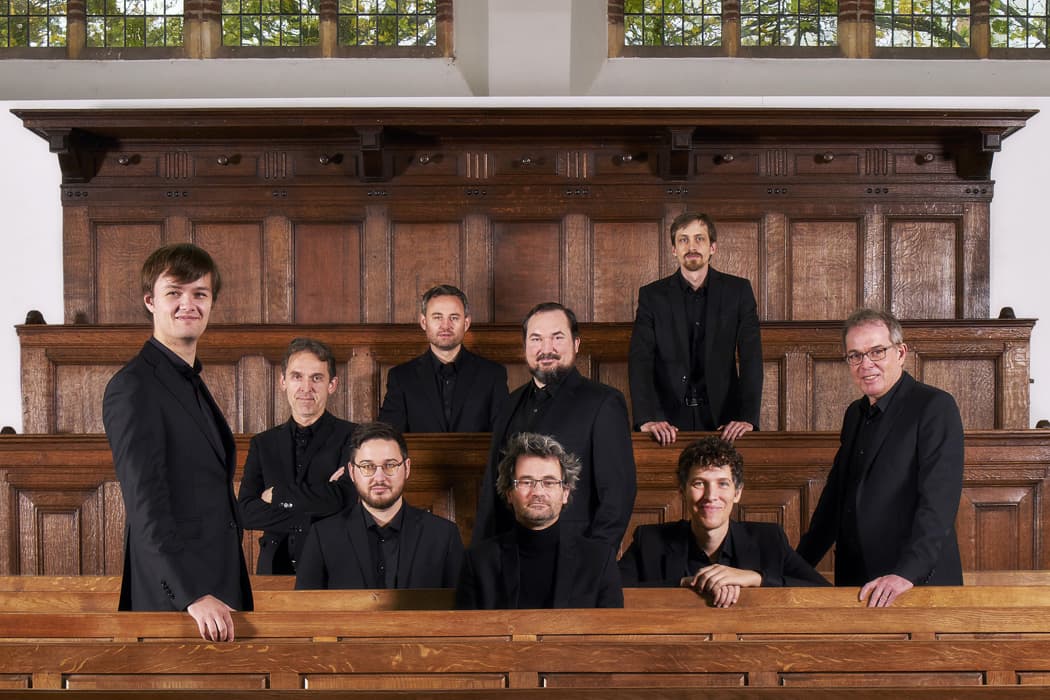
'From Rome to the Heights'
Special campus appearances by a renowned Renaissance vocal ensemble—which recently won the classical music equivalent of an Oscar—will showcase the intricate musical compositions of that period, and bring to life musical treasures from the collection of Boston College’s John J. Burns Library.
“From Rome to the Heights” features Dutch vocal group Cappella Pratensis, whose residency at BC will culminate in a rare opportunity to experience Renaissance polyphonic music, a style that interweaves melodic lines, performed directly from historical notation provided by the Burns archives.
On October 29, the group will conduct a daytime workshop/demonstration and perform an evening concert, offering opportunities for immersion in the artistry of Renaissance musicians. These appearances are sponsored by the Netherland-America Foundation “Bridging Worlds,” the Office of the Morrissey College of Arts and Sciences Dean, the Music Department, and University Libraries.
The group, which appears in prominent venues worldwide to critical acclaim, recently was presented with a Gramophone Classical Music Award—regarded as the most important prize in classical music—in the “Early Music” genre.

Music Department Chair and Professor Michael Noone
“For almost 40 years, Cappella Pratensis has been renowned for its innovative approach to the performance of Renaissance polyphonic music,” said BC Music Department Chair and Professor Michael Noone. “It is one of only a handful of professional ensembles in the world that perform directly from historical notation, as opposed to transcriptions in the form of a modern choral score. Just two weeks ago at the Catholic University in Belgium, the group sang twice for Pope Francis.”
Noone said the October 29 events promise to be “a memorable experience,” citing the importance of collaboration with Burns Library, which as part of the workshop will exhibit some of its very rare sacred music books from as early as the 14th century. The event will take place at noon in Gasson 100; lunch will follow.
Titled “Experience Renaissance Music Up Close: Witness a Guidonian Hand Signals Demonstration,” this exploration of Renaissance music performance will bring new life to the Burns Library’s rare Renaissance treasures. Cappella Pratensis will sing from the original notation, illustrating the complexity of Renaissance music through an interactive experience that illuminates their historical context and focuses on the lost art of hand signals as integral to the art of performance.
Among works to be explored is the Josquin des Prez composition “Inviolata,” to demonstrate the Guidonian hand and improvisation techniques, a mnemonic device used in the Middle Ages to help singers learn and memorize music. “Students will have the singular chance to sing with the Cappella Pratensis and experience firsthand the beauty of polyphonic music,” Noone said.
“Students, faculty, and visiting researchers come to Burns Library to see and study the rare and historical materials we hold in our varied collections, including the thoughtfully curated collection of choir books and manuscripts that we have developed over the years in consultation with Professor Noone,” said Associate University Librarian for Scholarly Resources and Burns Librarian Christian Dupont. “Yet it is an experience of another order to hear trained voices sing the early musical notations directly from their pages. It enriches understanding and appreciation literally beyond measure.”
.jpg)
"The Annunciation," one of the Alexander Locke windows in St. Mary's Chapel. (Gary Wayne Gilbert)
At 7:30 that evening, Cappella Pratensis will perform the “Missa Ecce Ancilla Domini” (“Behold the Handmaiden”), a setting of the Mass text by Franco-Flemish Renaissance master Guillaume Dufay, in St. Mary’s Chapel.
“Composed for the feast of the Annunciation, Dufay’s famous Mass has a special resonance for us at Boston College,” Noone said. “The Annunciation is exquisitely depicted in a painting at the center of the Gothic altarpiece that adorns the private oratory of the Loyola family in Azpeitia, Spain.” This beautiful Flemish painting was given by the Catholic Queen of Castile Isabella I to Magdalena de Araoz, her lady-in-waiting, when she married St. Ignatius’s elder brother, Martín.
Noone said that in 1915, then-BC President Charles W. Lyons S.J., commissioned Alexander Locke to produce stained glass windows for St. Mary’s Chapel. “It must have been this direct connection with the Loyola family oratory that led to the choice of the Annunciation as a theme for one of the north wall windows. In choosing to quote the archangel Gabriel’s words ‘Ave Maria,’ Locke was clearly acknowledging our chapel’s patron.
“Renaissance composer Palestrina’s magisterial setting of these words will resound in the chapel, brought to life by our visiting musicians.”
Cappella Pratensis will sing the "Ave Maria" from the original notation “as preserved in an exemplar of Palestrina’s motets printed in Venice in 1585,” Noone added. “This rare and exquisite publication found its way into the collection of the French conductor and pianist Alfred Cortot (1877-1962), and was acquired by Burns Library in 2019.”
For more information on these events, which are open to the public and free of charge, see the University events calendar.
